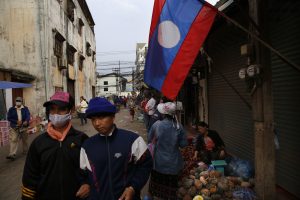After gambling with “high risk” levels of debt distress for more than a decade, Laos has fallen into a debt crisis (and possibly a trap).
The latest data indicate that Laos’ total public and publicly guaranteed (PPG) debt increased from 68 percent of GDP ($12.5 billion) in 2019 to 88 percent ($14.5 billion) in 2021. Debt is forecast to surpass 100 percent of GDP this year and to continue growing in the coming years. External public debt amounted to 66 percent of GDP in 2021, around half of which is owed to China.
This significant increase in PPG has been mainly driven by the economic impacts of the COVID-19 pandemic and the recent worsening global macroeconomic environment amid the war in Ukraine. It may be made worse still by slower GDP growth in China (a major trading partner and investor in Laos). At the height of the pandemic, global debt reached (and surpassed) wartime levels, with more than half of the world’s poorest countries experiencing or being at high risk of debt distress. Lebanon, Sri Lanka, Suriname, and Zambia have all defaulted on their external debt in recent years. And while the G-20’s pandemic-induced Debt Service Suspension Initiative (DSSI) provided some temporary repayment relief for 48 participating low-income countries, the initiative has now finished.
In Laos, economic growth – indispensable to offset rising debt levels and ensure debt sustainability – fell dramatically to around 5.5 percent in 2019 and -0.4 percent in 2020 (from 6.3 percent in 2018 and an average of 7.9 percent in the early 2010s). Growth remains below pre-pandemic levels, despite an estimated rebound to 2.5 percent in 2021. The value of the Lao economy and the cost of its debt have been further threatened by the depreciation of the kip: Its value plummeted by 35 percent between February 2021 and August 2022, with inflation rising from less than 2 percent to 30 percent over the same period.
Public debt service payments were estimated at 48 percent of total revenues in 2021 (down from an expected 65 percent in Laos’ 2021 plan only thanks to debt service deferrals granted by major lenders in 2020-2021). Interest payments are expected to overtake total government spending on health and education combined in the very near term. Reserves to external debt stocks ratios have constantly declined since the early 2010s and are widely considered to be insufficient to meet the required annual repayments of $1.2-1.4 billion to 2026. In August 2022, Fitch downgraded Laos’ Long-Term Foreign-Currency Issuer Default Rating (IDR) to “CCC-” – the lowest sovereign rating in Asia without a default.
Expectedly, the current crisis has led to much speculation about what the near-term future will bring, as well as extensive commentary on possible causes, culprits, and consequences. Although the recent shocks have been pivotal in pushing Laos toward the edge of a debt crisis and possible default, the country’s current predicament seems more deeply entrenched in economic vulnerabilities that are inherent to the growth-centric agendas that have guided much international development efforts from the mid-1980s onward.

































